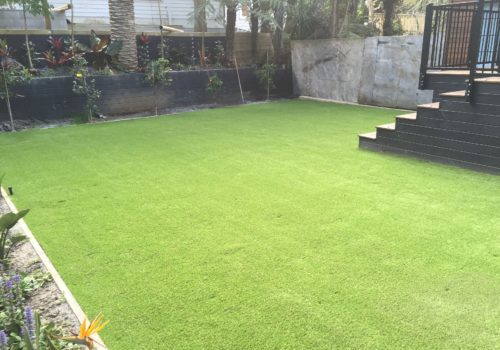Sometimes, especially in hot weather, lawns can dry up, become discolored, and leave empty patches.
If you want to find a way to repair your lawn and restore it to its optimum condition, biodegradable grass mats, also known as lawn seed blankets, are a way to patch up any empty patches in your lawn.
Placing seeds down straight onto the earth can be problematic as they can be easily washed away by severe weather conditions, like rain or wind.
So, instead, you can use biodegradable grass mats as an alternative – they work extremely well and provide you with great results!
What Do Biodegradable Grass Mats Do?
Instead of having empty patches in your lawn, biodegradable grass mats are a great way of practically sewing down some new seeds.
They’ll restore the condition of your grass and ensure that it’s looking less patchy.
If you place grass seeds straight onto the earth, then it’s also more difficult to make it even.
If you purchase a pre-seeded grass mat then they’ll have distributed the seeds out exactly where they need to be.
Biodegradable grass mats hold the seeds in place and reduce issues caused by weather or wildlife.
It’s a great way of protecting the seeds against birds or any pets that might dig up your lawn.
While biodegradable grass mats are often used for protection, they can also lock in an adequate amount of moisture for the grass to grow.
Are There Any Downsides to Biodegradable Grass Mats?
You’ve heard about a lot of the positives that biodegradable grass mats have to offer.
Now, we’re going to take a look at the downsides. The key disadvantage of biodegradable grass mats is their price.
As opposed to spreading inexpensive grass seeds, you’ll need to buy the mat separately, and that can be costly.
As they’re biodegradable and have numerous environmental benefits, they tend to be more expensive.
If you buy a biodegradable grass mat, there are also fewer options for seeds.
Although you can buy some grass mats pre-seeded, not all of them come with grass seeds, and they’re not always easy to find.
As grass tends to sprout at different times, depending on the weather conditions, you should purchase grass seeds that are the same as your current lawn.
If the timing is more aligned, then it’s easy to control and mow the lawn when necessary.
You’d have to source the seeds yourself and then cover them in fertilizer to ensure that they have the requirements to grow.
This method can not only be more costly, but more timely too!
How Are Biodegradable Grass Mats Used?
If you sprinkle the grass seeds straight onto the soil, it’ll result in bad germination.
You can place biodegradable grass mats over your existing grass.
Biodegradable grass mats act as a germination blanket by allowing water and light to the seeds and therefore help your lawn to grow.
So, what do you need to do with your biodegradable grass mat?
Firstly, we’ll list everything that you need to install your biodegradable grass mat, and then how you install it.
What you’ll need:
- Hose or Sprinkler
- Lawnmower
- Fertilizer
- Grass Seed
- Biodegradable Grass Mats
- Biodegradable Stakes
- Rake
- Mallet
- Scissors
Step 1
Mow the lawn in all areas, including the area where seeds will be placed and any nearby grass.
Step 2
Measure the sparse grass areas to determine exactly how much blanketing you’ll require. By knowing the exact measurements, you’ll reduce wastage.
Step 3
Where the sparse grass is, use a garden rake to remove any rocks, stones, or dead grass from the area. When doing this, try to loosen the soil by around 2 inches. This airs it out and helps the seeds to grow properly.
Step 4
Put fertilizer down on the sparse grass areas. If you want to, you could also add it to a larger area to revitalize the existing grass. Each fertilizer may differ slightly, so you should follow the instructions on the packaging accordingly.
Step 5
Evenly spread the grass seeds on your lawn.
You can either do this by hand or if it’s covering a larger area, use the broadcast seeding method.
Refer to the instructions on the seed’s packaging for more direction.
Step 6
Roll out the grass mats onto the sparse area with the thicker side of the netting facing upward.
Ensure that there are 3 inches on either side of the sparse area. Cut any remaining material off with scissors.
Step 7
In the edges of the blanket, secure the biodegradable stakes using a mallet.
Step 8
Soak the biodegradable mats using a hose, or with a sprinkler for larger grass areas. When water begins to run off them, you can stop watering them.
To ensure the upkeep of your grass, you should continue to water them until the grass sprouts between 2 to 3 inches through the blanket. After this, it’s then safe to mow these areas to maintain them.
Why Biodegradable?
Most biodegradable products, including biodegradable grass mats, break down easier and don’t harm the environment.
To be identified as biodegradable, the product must be able to quickly and effectively decompose into natural materials, like water vapor, carbon dioxide, or other organisms.
Conclusion
Overall, using biodegradable grass mats to patch up any bare, dead grass on your lawn is an extremely effective method.
Rather than having inconsistent patches, you can revitalize your lawn and make it look as good as new.


